Our Services
Tree Sales
Below is a list of trees that we may have available in our tree farm or have recently stocked. If you don’t see the type of tree you want, or if you have questions regarding the adaptability of a certain tree species to your area, just give us a call!
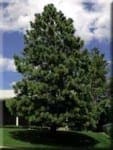
Ponderosa pine (Pinus ponderosa)
This tree is native to the Black Hills and has a broad, pyramidal form with dark green needles and scaly yellowish-brown to reddish-brown bark. It is a long-lived species well adapted to a wide range of soil types. This makes it well suited for transplanting. Ponderosa pine isn’t without its problems. Two pine beetles have recently taken their toll on pine trees and can be especially damaging on newly transplanted trees that aren’t fully established. For this reason, the Johnson Tree Company cannot warranty pines unless there is a commitment to treat these trees for these pests.
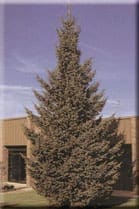
White spruce (Picea glauca)
White spruce is native to Canada and the northern United States. There is an isolated native population in the Black Hills that differs slightly from the general species. This population is known as Black Hills spruce (Picea glauca var. densata). Both have a dense pyramidal form with short (1/2″-3/4″), four sided, single, evergreen needles. The foliage of Black Hills spruce is a little more dense and darker green. They both can be adapted to many different planting sites with the Black Hills spruce being a little more adapted to harsher soil conditions. They both make excellent landscape specimens. The general white spruce growing to be 40′-60′ high and 10′-20′ wide, and the Black Hills spruce 20′-40′ high with a little narrower spread.
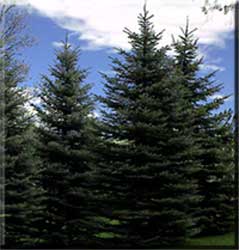
Colorado blue spruce (Picea pungens)
This spruce is native to the southwestern United States and is one of the most widely planted ornamental evergreens in South Dakota. It has a dense pyramidal form with single, evergreen needles 3/4″- 1 1/4″ in length. Needle color is what gives this spruce its popularity. It can range from green to blue depending on the seed source. It is tolerant of many different soil conditions and is considered the most drought-tolerant spruce. It does best, however, on moist well-drained soils. In landscape conditions expect Colorado blue spruce to reach 30′-60′ in height with a spread of 10′-20′.
Deciduous Trees
- Trees that shed leaves every autumn

Acer platanoides ‘Emerald Queen’
This is a cultivar of Norway maple. Norway maple comes from Europe and is a very popular landscape tree in the United States because of its rapid growth rate and dense rounded crown. ‘Emerald Queen’ is the cultivar probably best suited to South Dakota’s weather extremes. It has rapid growth, dark green leaves, and an oval-rounded outline. Fall color is bright yellow. At maturity this tree can attain a size of 50′ high by 40′ wide.
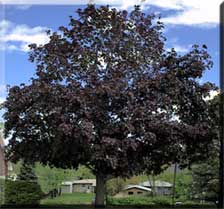
Acer platanoides ‘Crimson King’
This is a cultivar of Norway maple. Norway maple comes from Europe and is a very popular landscape tree in the United States because of its rapid growth rate and dense rounded crown. ‘Crimson King’ is best known for its rich maroon leaf color throughout the growing season. The unusual leaf color of this cultivar makes it a unique addition to any landscape. While it is not well suited to most areas of South Dakota, it can be grown successfully in the Rapid City and Black Hills area. ‘Crimson King’ can reach a height of 40′ to 50′ and a spread of 35′ to 45′.
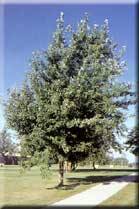
Acer saccharinum ‘Silver Queen’
This maple is a cultivated variety of South Dakota’s native silver maple. In South Dakota, silver maples are native only in the southeast corner of the state, but will grow quite well in the Black Hills area. They are fast growing trees that can tolerate a wide variety of soils, but do best in moist soils. Their maple shaped leaves have very deep lobes and the bark is gray-brown and smooth when young breaking into long out-curved plates with age. ‘Silver Queen’ has an upright oval-rounded form with leaves showing bright green above and silvery beneath. Fall color is yellow. ‘Silver Queen’ is mostly seedless, but does produce some seeds. It can grow to be 50′ high by 40′ wide.
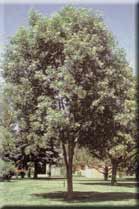
Fraxinus pennsylvanica ‘Patmore’
This tree is a cultivar of our native green ash. While green ash is native to river and stream banks, it is tolerant of a wide range of soil conditions. This, combined with its rapid growth rate, has made green ash the most widely planted shade tree in South Dakota. ‘Patmore’ has a symmetrical oval form, compound leaves with 5-7 glossy dark green leaflets, and ash-gray to gray-brown bark becoming furrowed with age. ‘Patmore’ is a very hardy cultivar, very well suited for South Dakota’s winters. It is also a seedless cultivar eliminating a messy crop of seeds in autumn. It can grow to be 45′ high by 35′ wide.
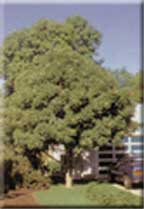
Aesculus flava
Yellow buckeye is not native to South Dakota and seldom seen planted. It is, however, adaptable to our part of South Dakota and given the right growing site can be a beautiful and unique addition to a landscape and add diversity to our urban forest. Yellow buckeye has an upright-oval to slightly spreading crown. Its unique leaves are palmately compound and dark green turning orangish in the fall. The bark is a combination of gray and brown becoming platy and scaly with age. The fruit is a smooth and pear-shaped capsule 2″-2 1/2″ (not edible). Yellow buckeye prefers a deep, moist, well-drained soil and can attain a height of 60′ or greater, but 40′ to 50′ would be more common in South Dakota.
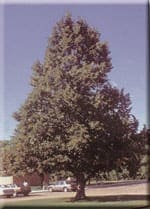
‘Redmond’ linden (Tilia americana ‘Redmond’)
This tree is a cultivar of our native basswood (also known as American linden). In South Dakota it is native to the extreme eastern part of the state. It is, however, quite well adapted to the Black Hills area. ‘Redmond’ has a pyramidal form that can become more rounded and oblong at maturity. The leaves are dark green, heart shaped, and large (4″-6″ long) turning yellow in fall. The bark is gray to brown with many long narrow ridges with age. It adapts to a wide range of soils, but does best on deep, moist, well drained soils where it can grow 60′-80′ with a spread 1/2 to 2/3 the height.

‘Greenspire’ littleleaf linden (Tilia cordata ‘Greenspire’)
‘Greenspire’ is a cultivar of the European littleleaf linden. It is also quite well adapted to the Black Hills area. It is very similar to our native basswood. It has a pyramidal form when young, becoming more rounded with age. The leaves are dark green, heart shaped, and as the name implies smaller (1 1/2″-3″ long) turning yellow in the fall. The flowers on this species can be quite showy. The bark is gray-brown becoming rigid with age. It is also tolerant of a wide range of soils, but does best on moist, well-drained soils. ‘Greenspire’ grows to be 40′ high with a 30′ spread.
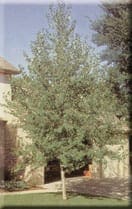
Quaking aspen (Populus tremuloides)
Quaking aspen is the most widely distributed tree of North America and is native to the Black Hills. It is fast growing with a pyramidal shape when young and a long trunk with a narrow rounded crown at maturity. It is adapted to a wide range of soil conditions and can attain a height of 40′-50′ with a spread of 20′-30′. Leaves are almost round, dark green above, light green below, turning yellow in the fall. The leaves flutter in the lightest breeze, hence the name. The bark is smooth greenish white to cream-colored when young (can be confused with paper birch (Betula papyrifera) from a distance) and becoming dark brown or gray and furrowed with age.

Hackberry (Celtis occidentalis)
Hackberry is a native tree to this area. It grows best in moist, well-drained soils, but can adapt to a wide range of conditions. Hackberry is a very nice tree for shade and can be a unique part of the landscape. It has unusual grayish bark with narrow corky projecting ridges. The hackberry has an upright leader and the crown is a broad top of ascending arching branches. The hackberry can reach heights of 40 to 60 feet with a nearly equal spread. The fruit of this tree is inconspicuous—about the size of a chokecherry. The color of the fruit is orange-red to dark purple, and attracts a wide variety of wildlife. Hackberry can have a very long life span of nearly two centuries. This native tree is ideal for most conditions in South Dakota.
Many of the trees we sell are from our own tree farm. Sometimes, however, we are unable to overwinter certain species, so we try to purchase anticipated trees in bulk every spring. Also at times we purchase small trees from a local nursery. Regardless of the source, the Johnson Tree Company can usually obtain any species of tree you wish.
the Johnson Tree Company specializes in buying, selling, and trading large trees. You can leave for work in the morning and have a mature, beautiful shade tree in your yard by the time you get home. Think about that!